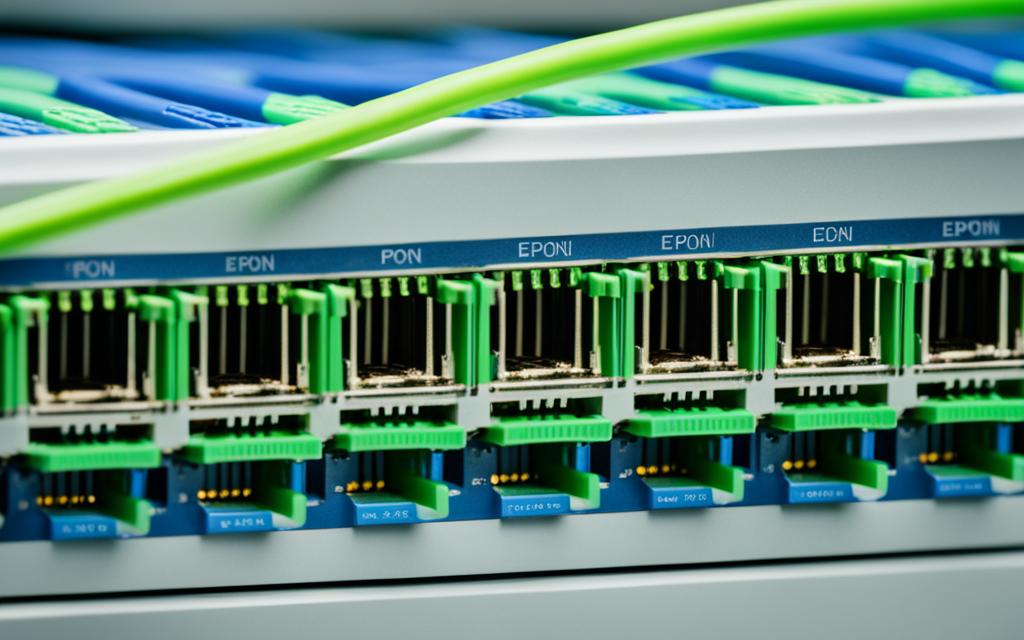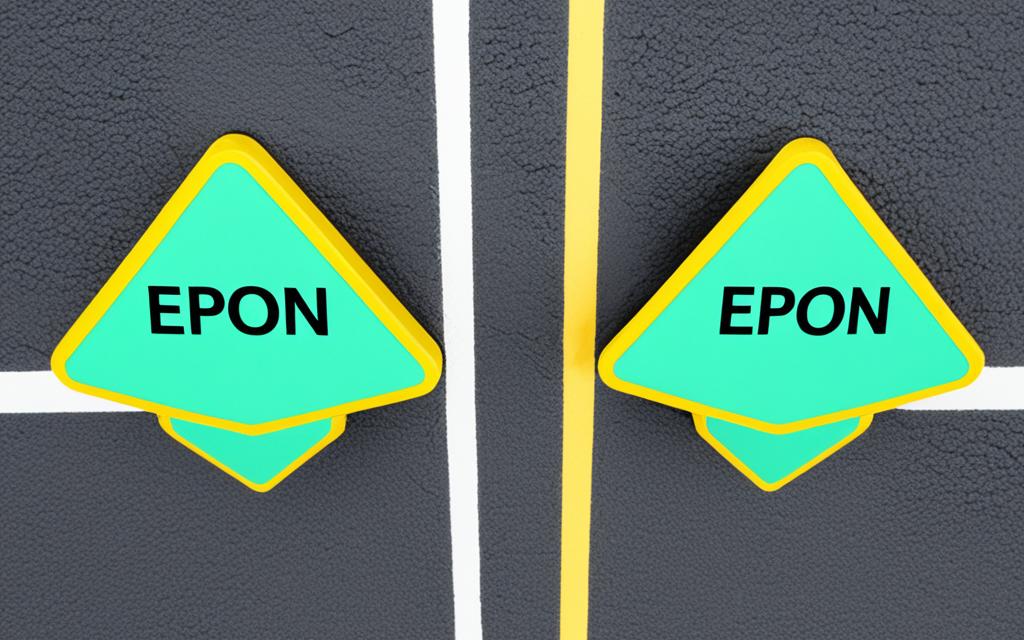Welcome to our comprehensive guide on Passive Optical Network (PON) standards. In this article, we will explore the key differences between two popular PON standards – GPON (Gigabit Passive Optical Network) and EPON (Ethernet Passive Optical Network). Understanding these standards is crucial for anyone involved in the deployment of fiber optic broadband services.
PON standards play a vital role in providing high-speed and reliable fiber optic communication to users. They utilize fiber optic cables and passive components to transmit data, revolutionizing the way broadband services are delivered. GPON and EPON are both widely used globally and offer distinct features and benefits.
In the following sections, we will explore the architecture and operation of PON technology, the specific features and benefits of GPON and EPON, and a detailed comparison of these two standards. We will also touch upon other PON standards such as BPON and 10G-PON/XG-PON, providing a comprehensive overview of the evolving PON landscape.
Whether you are a telecommunications professional, service provider, or simply interested in understanding PON standards, this article will equip you with the knowledge to make informed decisions regarding PON deployment. Let’s dive in and explore the world of GPON and EPON!
Understanding PON Technology and Architecture
A Passive Optical Network (PON) is a telecommunications network that utilizes fiber optic cables and passive components to transmit data. PON technology revolutionizes high-speed and reliable communication by efficiently delivering broadband services to users. The architecture of a PON consists of an Optical Line Terminal (OLT) located in the central office, and an Optical Network Unit (ONU) installed at the customer’s premises.
The OLT serves as the main hub of the PON network, receiving and transmitting data from/to the ONU. It connects the PON to the wider service provider’s network and is responsible for managing and controlling data traffic. The ONU, on the other hand, acts as a customer-side device, receiving and processing data sent by the OLT. It facilitates the last-mile connectivity, enabling users to access the high-speed fiber optic network.
One of the key advantages of PON technology is its use of passive components. This means that the data transmission does not require active electronic components, such as repeaters or switches, along the fiber optic lines, reducing the need for maintenance and power consumption. The passive network components, including splitters and couplers, enable the conversion of light signals into electrical signals and ensure efficient distribution of data to multiple end-users.
The PON architecture enables the sharing of optical fibers by multiple users, allowing for cost-effective deployment and maintenance. It also provides the ability to support various service types, including voice, data, and video, over a single fiber optic network. The high-capacity bandwidth of fiber optic cables ensures reliable and fast communication, meeting the increasing demands of modern applications and services.
Overall, PON technology and architecture play a vital role in the development of efficient and scalable fiber optic networks. The next section will focus on the features and benefits of GPON, a popular PON standard.
GPON: Features and Benefits
GPON, which stands for Gigabit Passive Optical Network, is a widely used PON standard that offers high-speed and efficient data transmission. With its advanced features and benefits, GPON has gained popularity in various applications. Let’s explore the key features and advantages of GPON:
Higher Speeds for Enhanced Performance
One of the significant advantages of GPON is its superior downstream and upstream speeds compared to EPON. GPON can deliver speeds of up to 2.5 Gbps downstream and 1.25 Gbps upstream, ensuring faster and reliable data transmission. This high-speed capability makes GPON suitable for bandwidth-intensive applications, such as video streaming, cloud computing, and online gaming.
Versatile Support for Different Traffic Types
GPON can handle both Ethernet and TDM (Time Division Multiplexing) traffic, offering support for a wide range of services. This flexibility allows GPON to accommodate legacy services like voice transmission, ensuring seamless integration with existing telecommunication networks. Additionally, GPON’s compatibility with Ethernet traffic enables the provision of high-quality data services across various industries.
Enhanced Protocol Efficiency
GPON utilizes advanced protocols to optimize bandwidth usage efficiently. By employing features like dynamic bandwidth allocation, GPON ensures efficient allocation of network resources based on specific requirements. This improved protocol efficiency translates to a better utilization of available bandwidth, reducing network congestion and enhancing overall performance.
Secure and Reliable Communication
GPON employs robust security mechanisms to ensure secure communication over fiber optic networks. With features like encryption and authentication, GPON safeguards data transmission against potential threats and unauthorized access. This level of security ensures the privacy and integrity of sensitive information, making GPON a preferred choice for secure communication networks.
Scalability for Future Growth
GPON technology offers scalability to accommodate future network expansion and increasing user demands. With GPON, service providers can easily upgrade their networks to meet growing bandwidth requirements and introduce new services without significant infrastructure modifications. This scalability feature enables seamless evolution and provides a cost-effective solution for long-term network planning.
“GPON’s ability to offer higher speeds, support diverse traffic types, and ensure efficient protocol utilization makes it a powerful solution for modern communication networks.”
– An industry expert
To summarize, GPON, or Gigabit Passive Optical Network, provides a range of features and benefits that make it an ideal choice for high-speed and versatile communication networks. With its higher protocol efficiency, support for different traffic types, and secure transmission, GPON offers enhanced performance, scalability, and reliability. The widespread adoption of GPON demonstrates its ability to meet the evolving demands of modern network infrastructure.
| Features | Benefits |
|---|---|
| High-speed transmission | Allows faster data transfer for bandwidth-intensive applications |
| Versatile support for different traffic types | Enables integration of legacy services and compatibility with Ethernet-based applications |
| Enhanced protocol efficiency | Optimizes bandwidth utilization and reduces network congestion |
| Secure and reliable communication | Ensures data privacy, integrity, and protection against unauthorized access |
| Scalability for future growth | Allows for easy network expansion and cost-effective upgrades to meet increasing demands |
EPON: Features and Benefits
EPON, which stands for Ethernet Passive Optical Network, is a widely adopted PON standard known for its seamless integration into modern IP-based networks. It utilizes Ethernet packets, making it compatible with existing Ethernet networks and facilitating efficient data transmission. EPON offers symmetrical speeds of 1 Gbps downstream and 1 Gbps upstream, providing high-speed data delivery and supporting various Ethernet-based services.
One of the key features of EPON is its cost-effectiveness. EPON networks require less optical fiber and fewer active components, resulting in lower installation and maintenance costs compared to other PON standards. This makes EPON an attractive choice for service providers looking to deploy cost-efficient fiber optic networks while delivering reliable and high-performance broadband services.
Furthermore, EPON’s compatibility with Ethernet networks makes it highly versatile. It seamlessly integrates with existing Ethernet infrastructure, allowing service providers to leverage their investments in Ethernet equipment and easily upgrade to EPON without significant disruptions. This compatibility ensures smooth migration and scalability, making EPON an ideal choice for network expansion and future growth.
To summarize, EPON’s key features and benefits include:
- Seamless integration with modern IP-based networks
- Symmetrical speeds of 1 Gbps downstream and 1 Gbps upstream
- Cost-effectiveness through reduced fiber and component requirements
- Compatibility with existing Ethernet networks for easy migration and scalability
Overall, EPON offers service providers a cost-effective and versatile solution for delivering high-speed data and supporting Ethernet-based services. Its features and benefits make EPON a compelling choice in the ever-expanding world of fiber optic broadband networks.
EPON Speed Comparison
The table below compares the downstream and upstream speeds of EPON with other PON standards:
| PON Standard | Downstream Speed | Upstream Speed |
|---|---|---|
| GPON | 2.5 Gbps | 1.25 Gbps |
| 10G-PON | 10 Gbps | 10 Gbps |
| EPON | 1 Gbps | 1 Gbps |
As shown in the table, EPON offers symmetrical speeds of 1 Gbps downstream and 1 Gbps upstream, making it suitable for high-speed data delivery and enabling efficient communication.

Comparison of GPON and EPON
In this section, we will compare GPON and EPON in terms of bandwidth, architecture, applications, cost, and global adoption. Understanding the differences between these two PON standards is crucial in determining the most suitable choice for your specific needs. Let’s dive into the comparison!
Bandwidth
GPON offers higher downstream bandwidth compared to EPON. With GPON, users can experience faster download speeds, making it ideal for bandwidth-intensive applications such as streaming high-definition videos or online gaming. EPON, on the other hand, provides symmetrical speeds of 1 Gbps downstream and 1 Gbps upstream, which makes it more suitable for applications where symmetrical data transfer is required.
Architecture
The architecture of GPON and EPON differs in terms of the protocol used for data transmission. GPON combines both Ethernet and TDM (Time Division Multiplexing) traffic, allowing for greater flexibility and support for legacy services like voice. EPON, on the other hand, utilizes Ethernet packets, making it seamlessly integrated into modern IP-based networks.
Applications
GPON’s ability to handle both Ethernet and TDM traffic makes it a more versatile choice for various applications. It can support a wide range of services, including voice, video, and data. EPON, although limited to Ethernet-based applications, provides excellent support for high-speed data transfer and is commonly used in areas where Ethernet connectivity is the primary focus.
Cost
EPON is generally considered to be more cost-effective compared to GPON. Its simpler architecture and use of Ethernet technology make it more affordable, especially for small-scale deployments. GPON, with its added versatility and support for legacy services, may require higher initial investment and maintenance costs.
Global Adoption
While both GPON and EPON have seen widespread adoption, their popularity varies by region. GPON is more commonly deployed in North America and Europe, while EPON has gained significant traction in Asia, specifically in countries like Japan and China. Factors such as regulatory requirements, infrastructure availability, and service provider preferences contribute to the global adoption patterns.
Ultimately, the choice between GPON and EPON depends on your specific needs, regional considerations, existing infrastructure, and long-term strategy. Analyzing the differences outlined in this section will help you make an informed decision for the successful implementation of a PON network.
| Comparison | GPON | EPON |
|---|---|---|
| Bandwidth | Higher downstream bandwidth | Symmetrical 1 Gbps downstream and 1 Gbps upstream |
| Architecture | Combines Ethernet and TDM traffic | Utilizes Ethernet packets |
| Applications | Supports Ethernet, TDM, voice, video, and data | Primarily Ethernet-based applications |
| Cost | Higher initial investment and maintenance costs | More cost-effective |
| Global Adoption | Popular in North America and Europe | Gaining traction in Asia |

Other PON Standards: BPON and 10G-PON
Apart from GPON and EPON, there are other PON standards worth mentioning. BPON, or Broadband Passive Optical Network, was the first-generation PON standard that paved the way for fiber optic broadband services. However, BPON has been surpassed by the superior speeds and capabilities of GPON and EPON.
The next-generation PON standard to look out for is 10G-PON, also known as XG-PON. 10G-PON offers even higher speeds and coexistence with existing GPON infrastructure, providing an upgrade path for networks. This technology brings significant advancements in data transmission, allowing for faster and more efficient broadband connections.
Let’s take a closer look at these two PON standards:
BPON
BPON was the pioneering PON standard that introduced fiber optic connectivity for broadband services. Although it laid the foundation for future advancements, including GPON and EPON, BPON is now considered outdated due to its limited speed and capacity.
Key Features of BPON:
- Downstream data rates of up to 622 Mbps
- Upstream data rates of up to 155 Mbps
- Support for voice, data, and video services
- Used mostly in early fiber builds
10G-PON (XG-PON)
10G-PON, also known as XG-PON, is the next-generation PON standard that builds upon the success of GPON and EPON. It offers significantly higher speeds, making it ideal for bandwidth-intensive applications and future-proofing networks.
Key Features of 10G-PON:
- Downstream data rates of up to 10 Gbps
- Upstream data rates of up to 2.5 Gbps
- Coexistence with existing GPON infrastructure
- Enhanced capacity for high-bandwidth services
BPON and 10G-PON represent important milestones in the evolution of PON technology. While BPON laid the groundwork, 10G-PON opens up new possibilities for high-speed broadband and advanced applications.
Conclusion
In conclusion, PON deployment has revolutionized the world of fiber optic broadband services, providing users with high-speed and reliable connectivity. The adoption of PON standards such as GPON and EPON has played a crucial role in enabling fast internet access and supporting various applications in different regions.
GPON offers advanced features like higher bandwidth and the ability to handle both Ethernet and TDM traffic, making it a versatile choice for service providers. On the other hand, EPON boasts symmetrical speeds and cost-effectiveness, making it an attractive option for delivering high-speed data and supporting Ethernet-based services.
The global deployment of PON networks continues to expand, bridging the digital divide and meeting the growing demand for faster and more reliable internet connections. Furthermore, the advancements in PON technology, particularly the emergence of 10G-PON, have opened up new possibilities and opportunities for network expansion, allowing for even higher speeds and coexistence with existing GPON infrastructure.
FAQ
What is a Passive Optical Network (PON)?
A Passive Optical Network (PON) is a telecommunications network that uses fiber optic cables and passive components to transmit data. It consists of an Optical Line Terminal (OLT) in the central office and an Optical Network Unit (ONU) at the customer’s location.
What is GPON?
GPON stands for Gigabit Passive Optical Network and is a widely used PON standard. It offers higher downstream and upstream speeds compared to EPON, making it suitable for various applications. GPON can handle both Ethernet and TDM traffic, providing support for legacy services like voice.
What is EPON?
EPON stands for Ethernet Passive Optical Network and is another popular PON standard. It utilizes Ethernet packets and is seamlessly integrated into modern IP-based networks. EPON offers symmetrical speeds of 1 Gbps downstream and 1 Gbps upstream, making it suitable for delivering high-speed data and supporting Ethernet-based services.
How do GPON and EPON compare?
GPON offers higher downstream bandwidth and can handle both Ethernet and TDM traffic, making it more versatile. EPON, on the other hand, is more cost-effective and widely adopted in certain regions. The choice between GPON and EPON depends on specific needs, regional preferences, infrastructure, and long-term strategy.
What are some other PON standards?
Apart from GPON and EPON, there are other PON standards worth mentioning. BPON (Broadband Passive Optical Network) was the first-generation PON standard but has been superseded by GPON and EPON due to their superior speeds and capabilities. 10G-PON (also known as XG-PON) is the next-generation PON standard that offers even higher speeds and coexistence with existing GPON infrastructure.



















